This easy, soft, moist vanilla tray bake or vanilla sheet cake comes together quickly with a few pantry ingredients.
This delicious from-scratch homemade tray bake is topped with a simple vanilla buttercream that can be decorated with sprinkles for that old school sprinkle cake feel.
I love this vanilla sheet cake - I think it is perfect for any special occasion such as birthdays, office parties, holidays, and bake sales. This recipe results in a tray bake that is over an inch tall and can be topped with vanilla or chocolate buttercream, or a soft delicious cream cheese frosting.
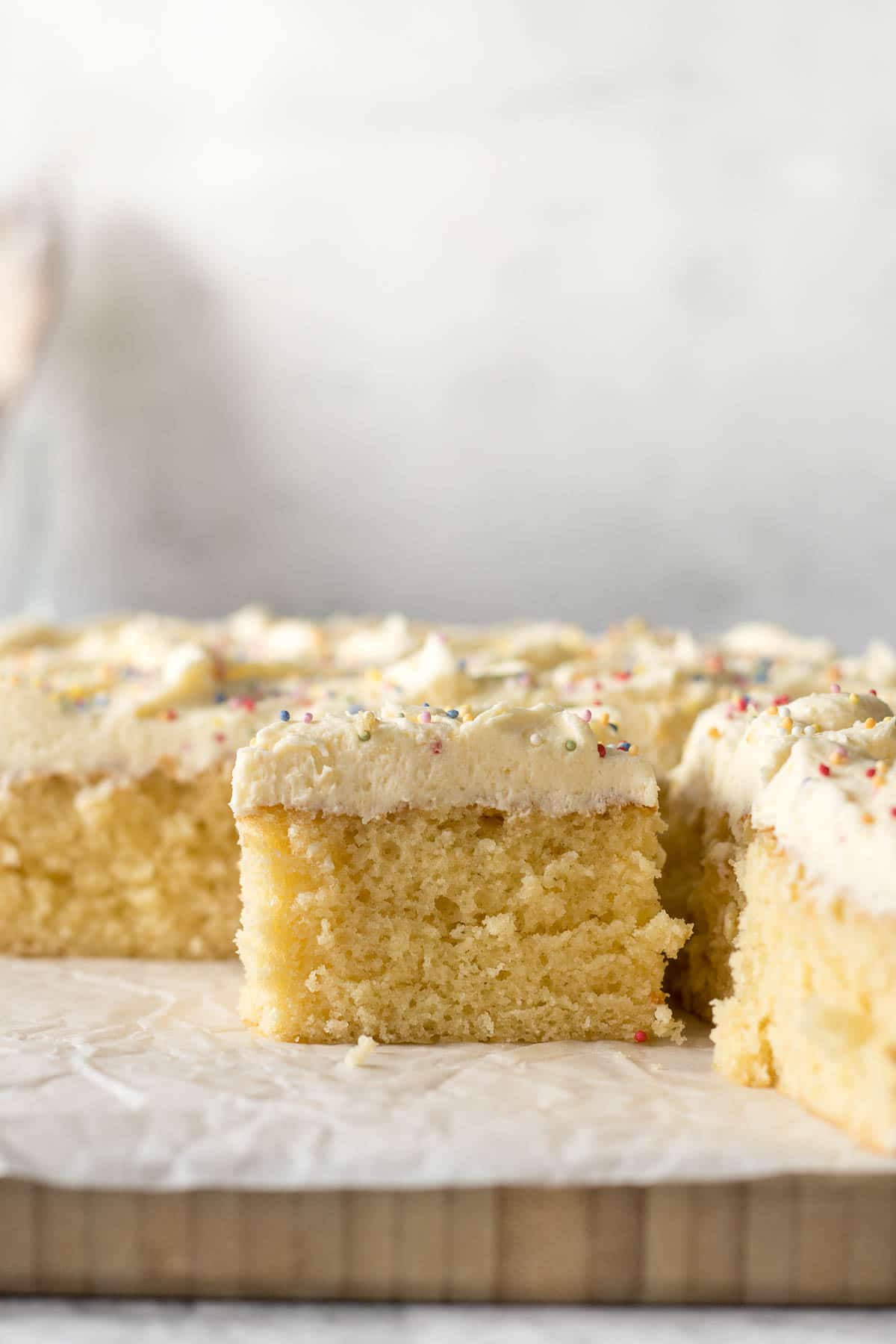
Jump to:
Development/Update Notes
This particular vanilla sheet cake recipe was developed from a mash-up of my and my bestie's recipe. We compared notes and this recipe was born. And then this recipe was updated to the method I use today in 2020/2021 because I was living in a cold house in Christchurch, and getting everything to room temperature for a cake seemed impossible.
2024 update: Over on Pinterest I have had a few comments that this cake came out dryer than expected. The main reasons a cake can be dry can be overbaking, in an oven, eggs that are too small, or adding too much flour.
So I decided to retest the recipe as is- it came out perfect for me. Then I tested with additional butter and eggs, and I didn't like the outcome. Then I decided to test my original recipe and drop the flour content by 50 grams.
And the result was a super soft, moist plain vanilla sponge. So in the recipe card I have updated the recipe to 250 grams of flour, but have also noted the original measurements for those who love the original recipe.
Ingredients
Here are some notes on the ingredients used in this recipe. Please see the recipe card for quantities.
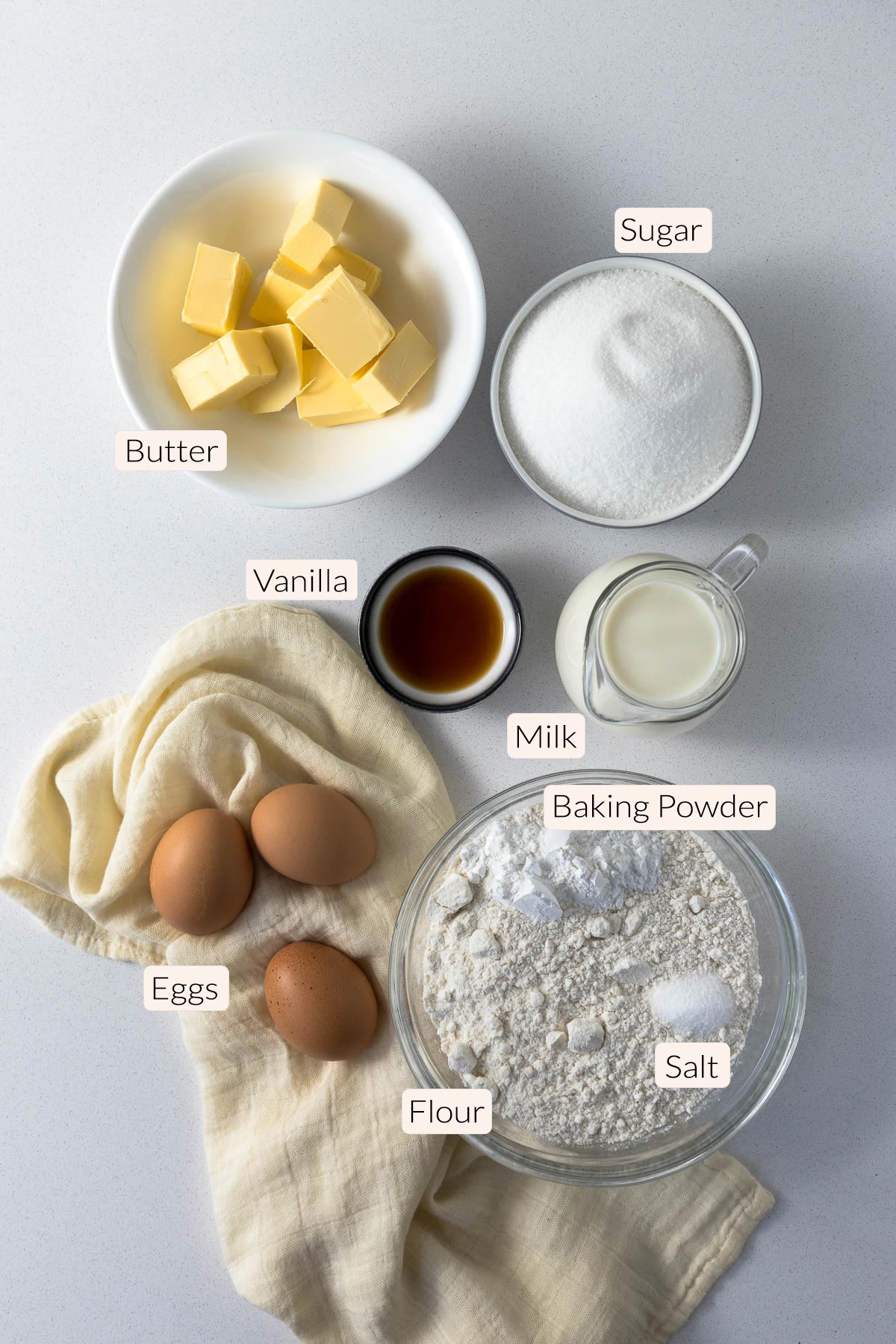
- Plain flour - plain all-purpose or standard-grade flour for this recipe. The updated recipe calls for 2 cups of flour in total, if using a self-raising or self-rising flour, I would still whisk through an additional 2 teaspoons of baking powder.
- Baking powder gives this cake its lift during the baking process. Make sure you are using fresh or active baking powder by adding some to a bit of boiling water. If it fizzes, then it is fresh and active. If baking at altitude I would decrease the baking powder to 3 teaspoons in total.
- Butter adds flavor, softness, and moisture to the cake. This can be replaced with baking margarine. I also use butter for the frosting.
- Eggs also add flavor, lift, and moisture to the cake. I have used size 6 and 7 eggs, which are the equivalent of medium/large eggs.
- White granulated sugar adds sweetness to this cake but is also responsible for holding onto moisture. I do not recommend reducing the sugar in this recipe.
- Milk - I use whole milk or full cream milk for baking, however, you can get away with using a reduced-fat variety.
- Salt is a crucial ingredient for baked goods. If using self-raising or self-rising flour, and/or salted butter you can skip the additional salt.
- Vanilla extract is the driving force behind the flavor of this cake. Use a good vanilla extract or paste.
- Icing sugar, powdered sugar, or confectioner's sugar for the buttercream frosting.
Making the Vanilla Tray Bake Cake
Step 1 - Preheat the oven to 180°C/350°F. Grease and line a 9"x13" (23cm x 33cm) rectangular cake tin.
Step 2 - Whisk together the flour, baking powder and salt. Set aside. Melt the butter and allow it to cool while moving on to the next step.
Note - When measuring flour with a cup, make sure to first fluff the flour in the container. Then spoon the flour into the cup before levelling off with the back of a knife.
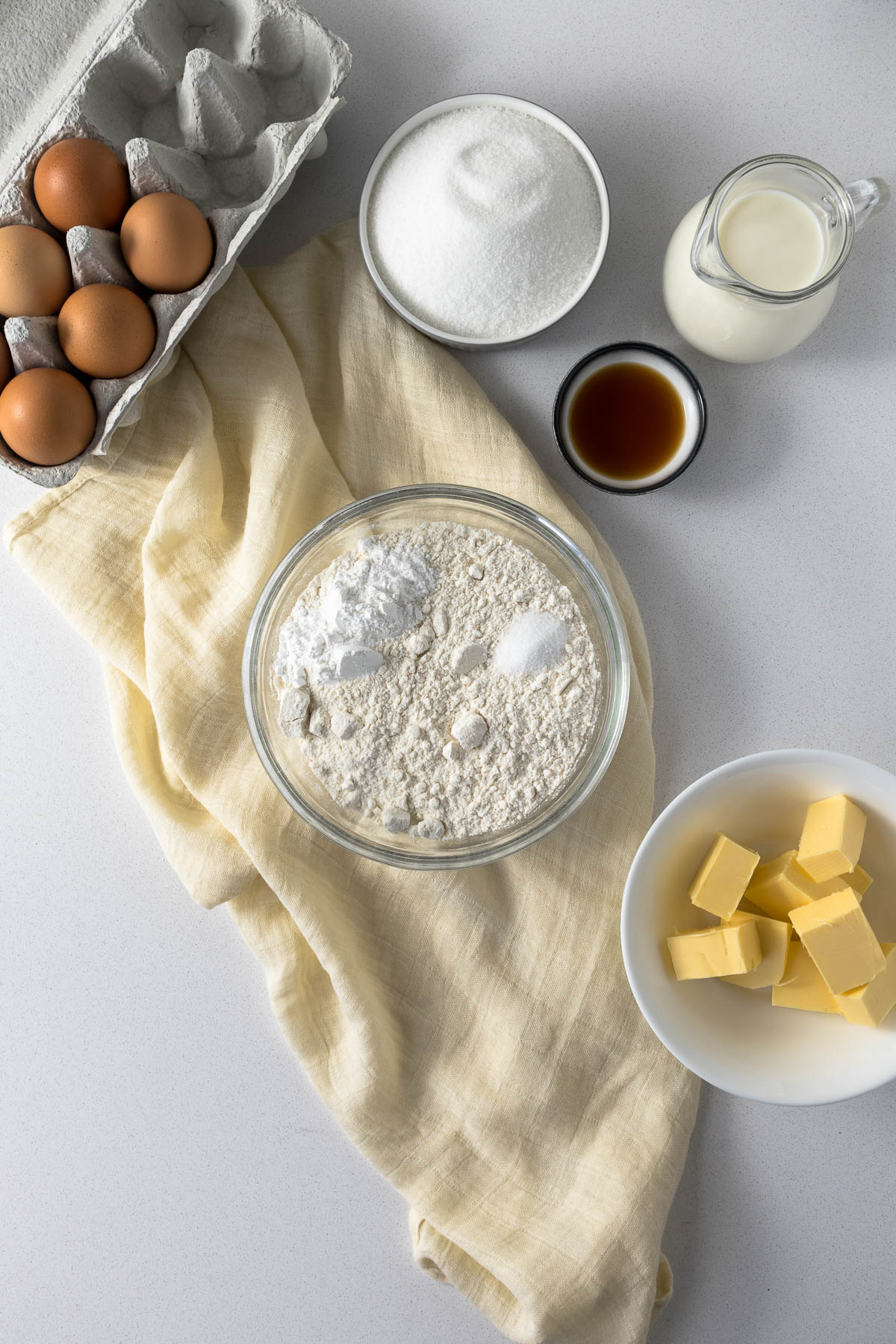
Step 3- In a large mixing bowl beat the eggs and sugar until light and fluffy and has doubled in volume. About 3-5 minutes using an electric hand mixer/stand mixer.
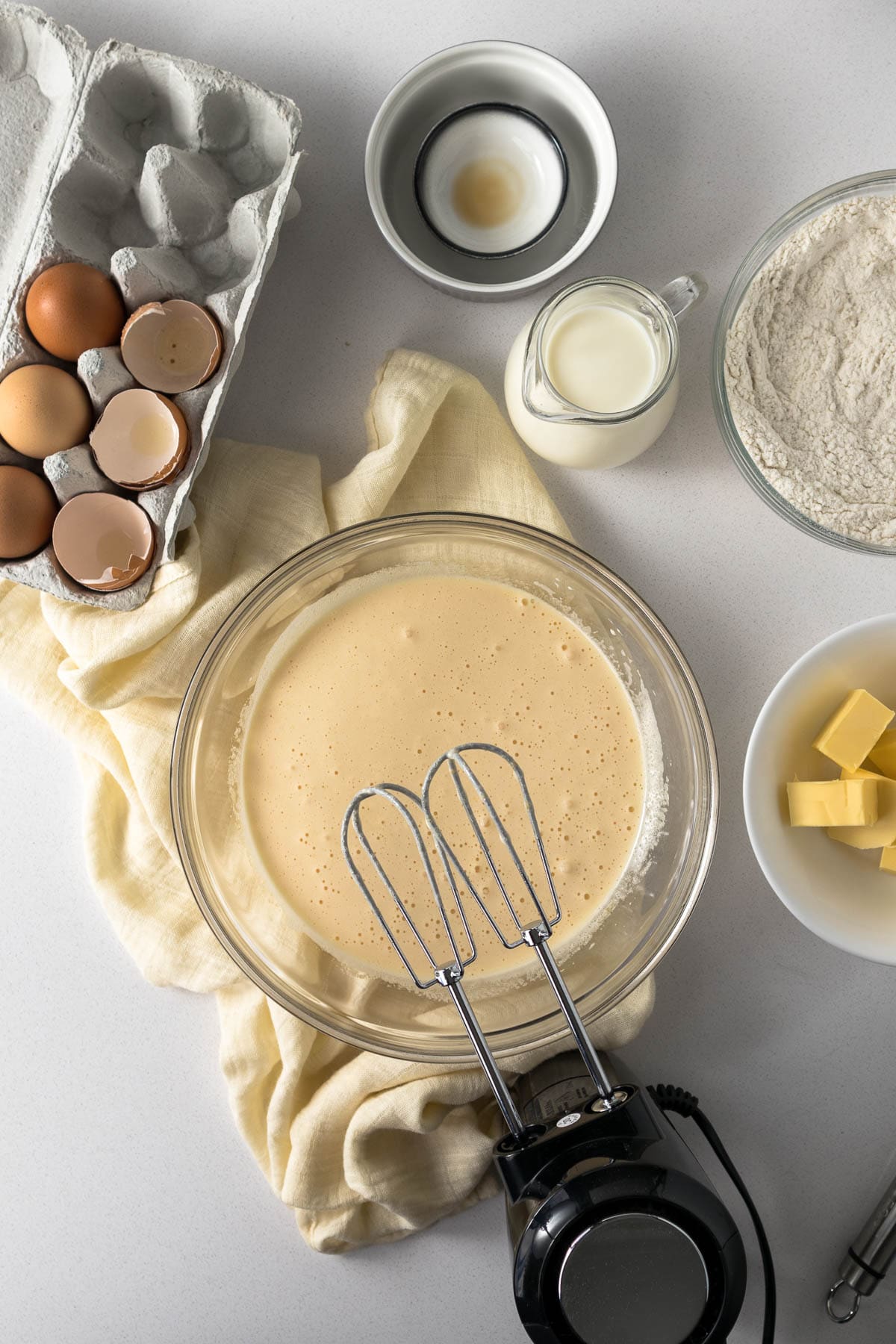
Step 4 - Add in the vanilla and mix through. Then pour the butter slowly down the side of the bowl with the mixer running. Mix until well combined. Similarly, add in the milk and mix through.
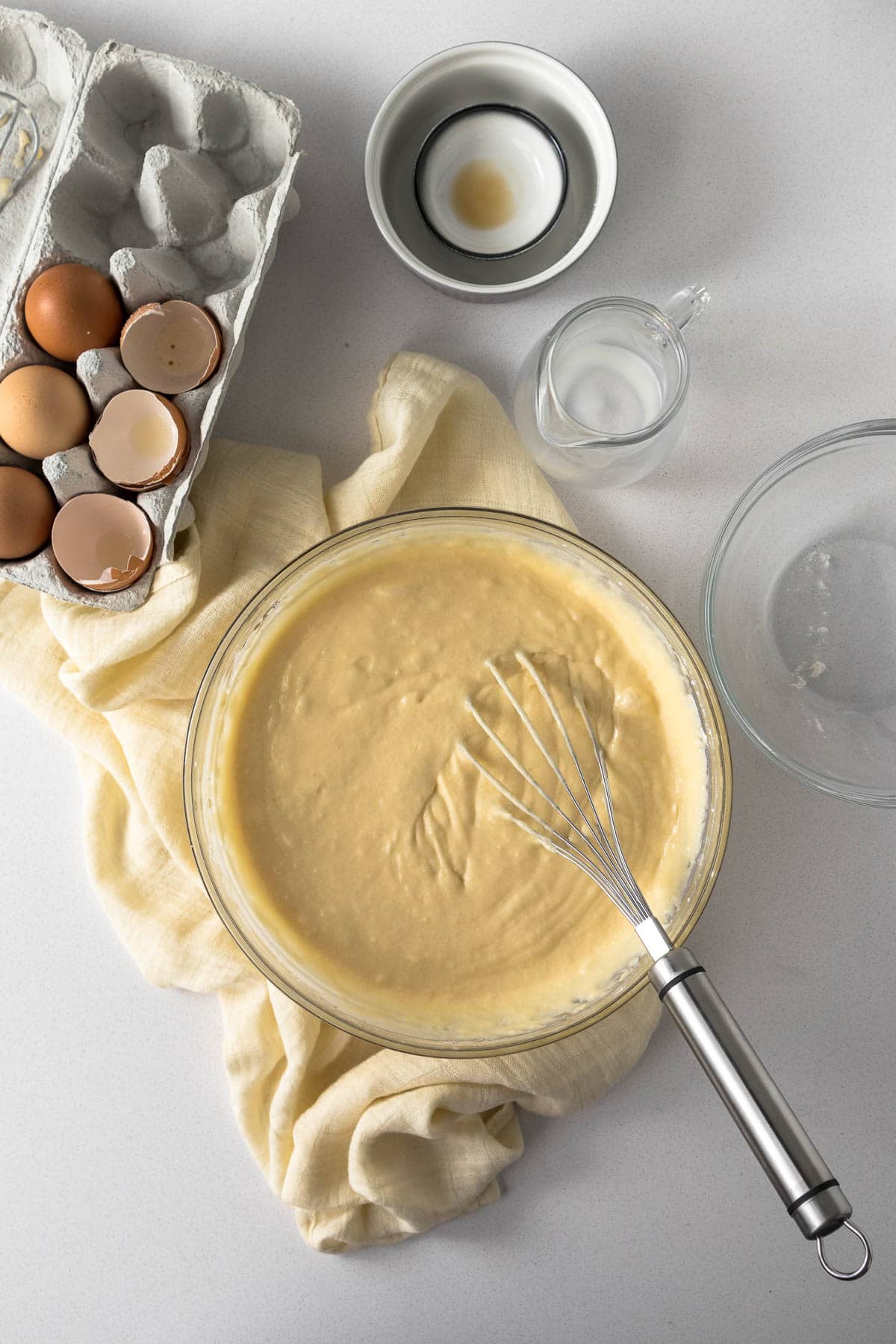
Step 5 - Add in half the flour mixture and mix through on a low speed. Then add in the other half and mix until combined. You can finish this off by hand to prevent overmixing.
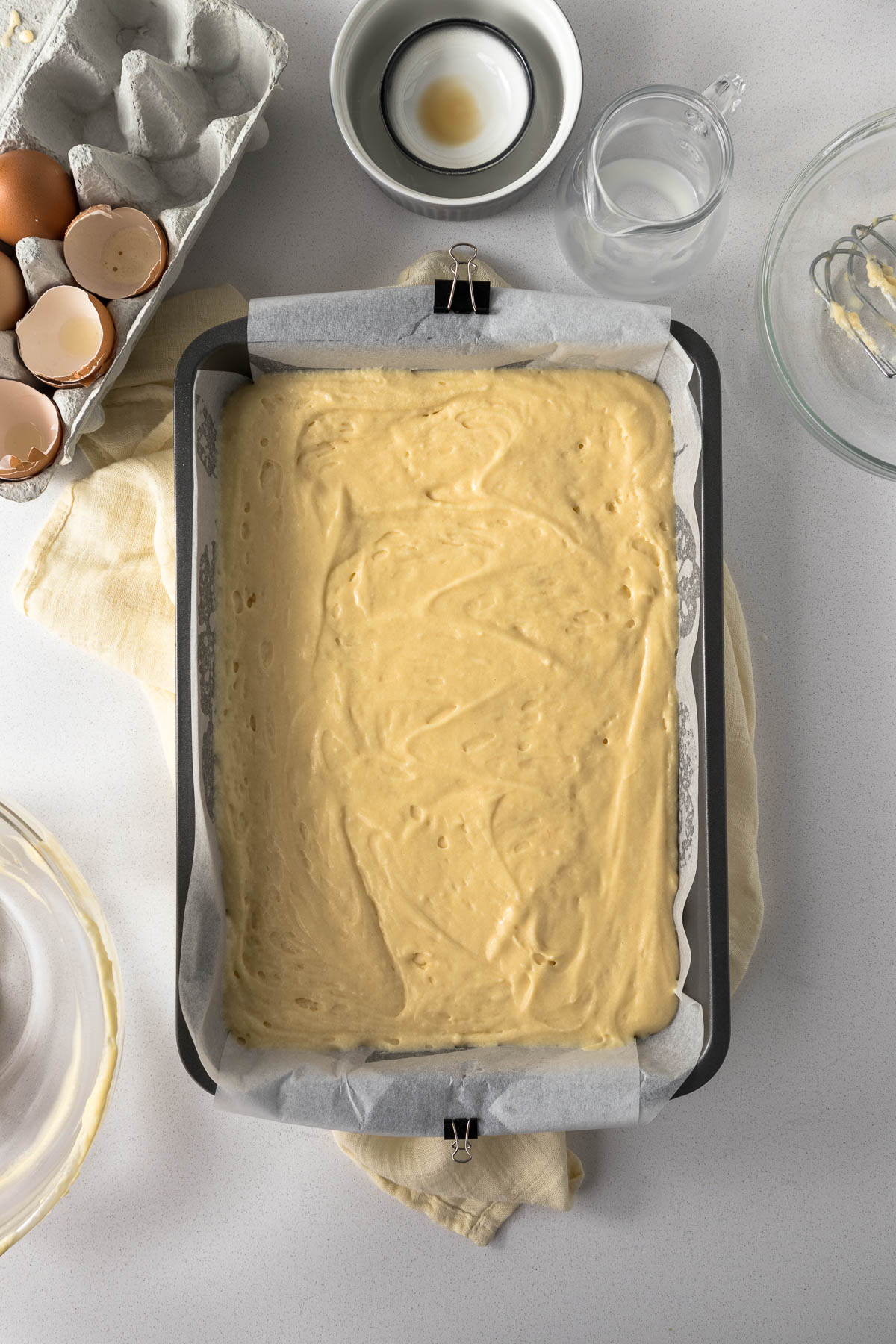
Step 6 - Pour the sponge batter into the prepared baking pan. Smooth to the edges. Bake for 30-40 minutes or until a cake tester comes out clean from the center of the cake. Cool in the tin for 10 minutes before turning out onto a cooling rack to completely cool.
A note on the icing/frosting - the icing or frosting can easily be halved if you prefer less icing or frosting on the cake. If you make the full batch and decide it's a bit too much frosting for your liking, you can freeze buttercream frosting for up to 3 months in an airtight container/freezer bag.
Step 7 - To make the icing/frosting, beat the butter until the butter has lightened in color. Add in the vanilla and salt, and beat together. (If using the stand mixer, use the whisk attachment).
Step 8 - Add in the icing sugar one-third at a time, and mix thoroughly. Add in 4 to 8 tablespoons of milk (start with 4 and work your way up.) and mix until you have a soft spreading consistency. Then beat the frosting for 3 to 5 minutes until soft, fluffy, and ready for spreading.
Step 9 - Plop the frosting/icing over the top of the completely cooled cake, and smooth until mostly even using an offset spatula or the back of a dessert spoon. Then create swirly patterns on the top if desired.

Making Vanilla Cupcakes
This recipe can be used to make about 16-18 cupcakes, however, if that is what you are looking for I highly recommend you try out my perfect vanilla cupcake recipe!
That being said, if you want to use this recipe follow the instructions to make the cake batter. Then divide the batter equally among the cupcake liners, filling each cupcake liner about ⅔ full. Bake for 18-22 minutes or until a cake tester comes out clean from the center of the cupcakes. Allow to cool completely on a wired rack before frosting/icing the cupcakes with buttercream or cream cheese frosting.
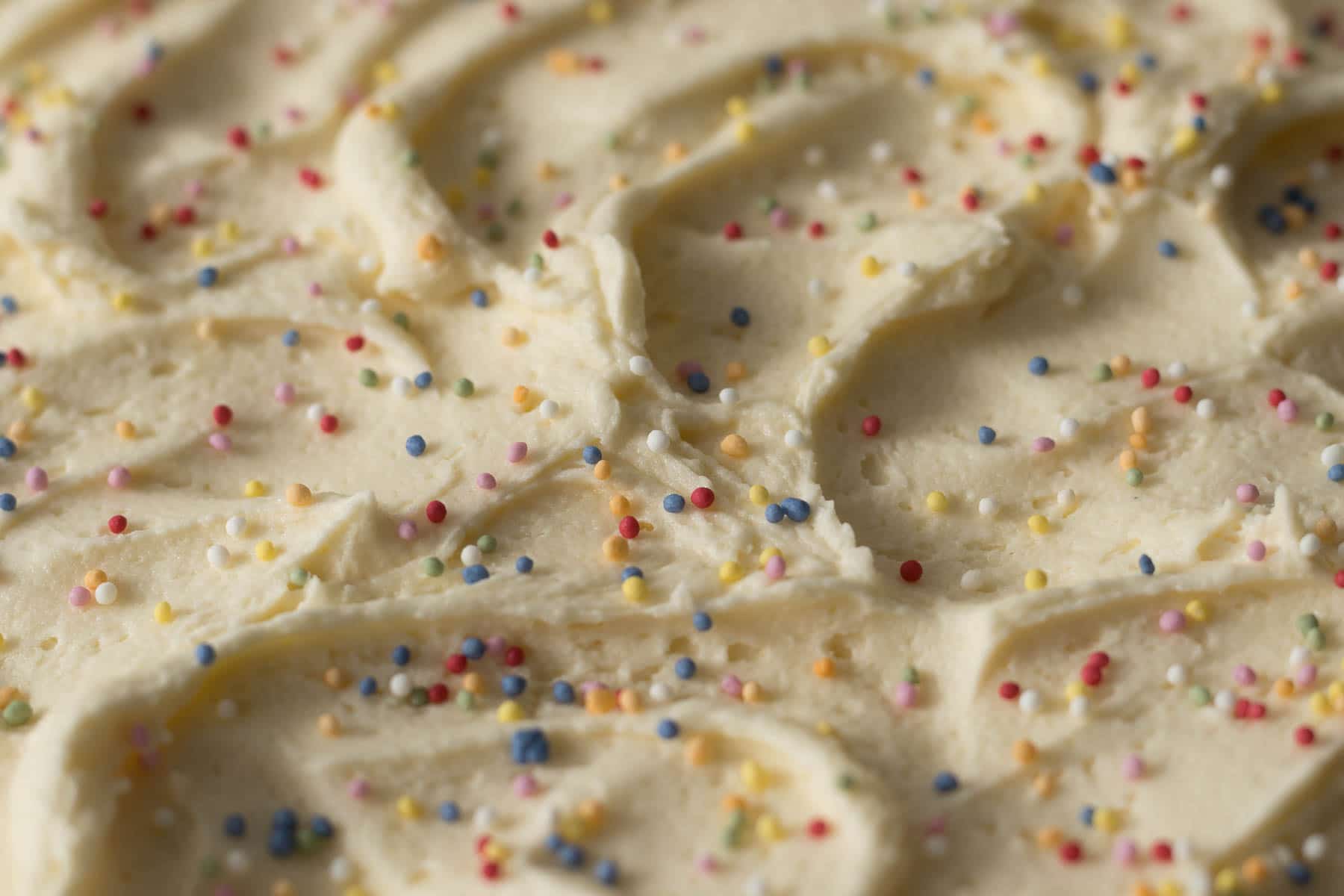
Expert Tips for This Recipe
- Preheat your oven properly baking the cake. This will take about 20 minutes (the time it takes to prepare the cake batter).
- If using a fan-assisted or fan-forced oven, reduce the temperature by 20°C/25°F
- For best baking results I recommend using an oven thermometer.
- Remember that all ovens work slightly differently and bake times may need to be adjusted for your specific oven.
- If possible use a light colored metal baking pan. If yours is dark like mine, I like to wrap the outside of the pan with foil to prevent the edges from baking too quickly.
- The sides of the cake pan need to be greased to allow the edges of the cake to rise up during the baking process with the center of the cake.
- Use a kitchen scale to weigh out ingredients. Or a nice set of measuring cups and spoons.
- When measuring flour with cups, first fluff the flour up in the container where the flour is kept, then spoon the flour into the cup and level the cup off with the back of a knife.
- The cake is done when a toothpick comes out clean from the middle of the cake (I like to test 3 to 4 spots to be certain).
- Allow the cake to cool completely before frosting or the the frosting will melt into the cake.
- My recipes are currently only tested at sea level and may require a few adjustments if you live at a higher altitude such as by decreasing the baking powder to 3 teaspoons and checking on the doneness at 25 minutes.
Can I bake this cake in other-sized cake pans?
In my original recipe with a total of 300 grams of flour, I would easily split between two 8-inch (20cm cake) pans and bake for about 20-30 minutes. So I reckon it would probably work fine for the updated version with 250 grams of flour. However, these won't be super tall layers.
Can I bake all the batter in a 9-inch square (23cm square) cake pan or a 9-inch round cake pan- because this recipe makes about 4 ½ cups of batter, this recipe should be able to be baked perfectly fine in a 9-inch square or round cake pan. The baking time will probably need to be increased to 40-50 minutes. Just keep an eye on it.
Storage and Freezing
This vanilla traybake cake can be stored at room temperature for 3 to 4 days in an airtight container. If you live in a warm climate and prefer keeping your cake in the fridge please store it in an airtight container and allow it to come to room temperature before serving.
This cake can be frozen in individual pieces wrapped in cling film or plastic wrap and then in an airtight container for up to 3 months. Remove the cling film before defrosting to ensure the icing or frosting doesn't stick to the cling film.
If topping the cake with cream cheese frosting, the cake will need to be stored in the fridge in an airtight container.
Other Recipes You May Like
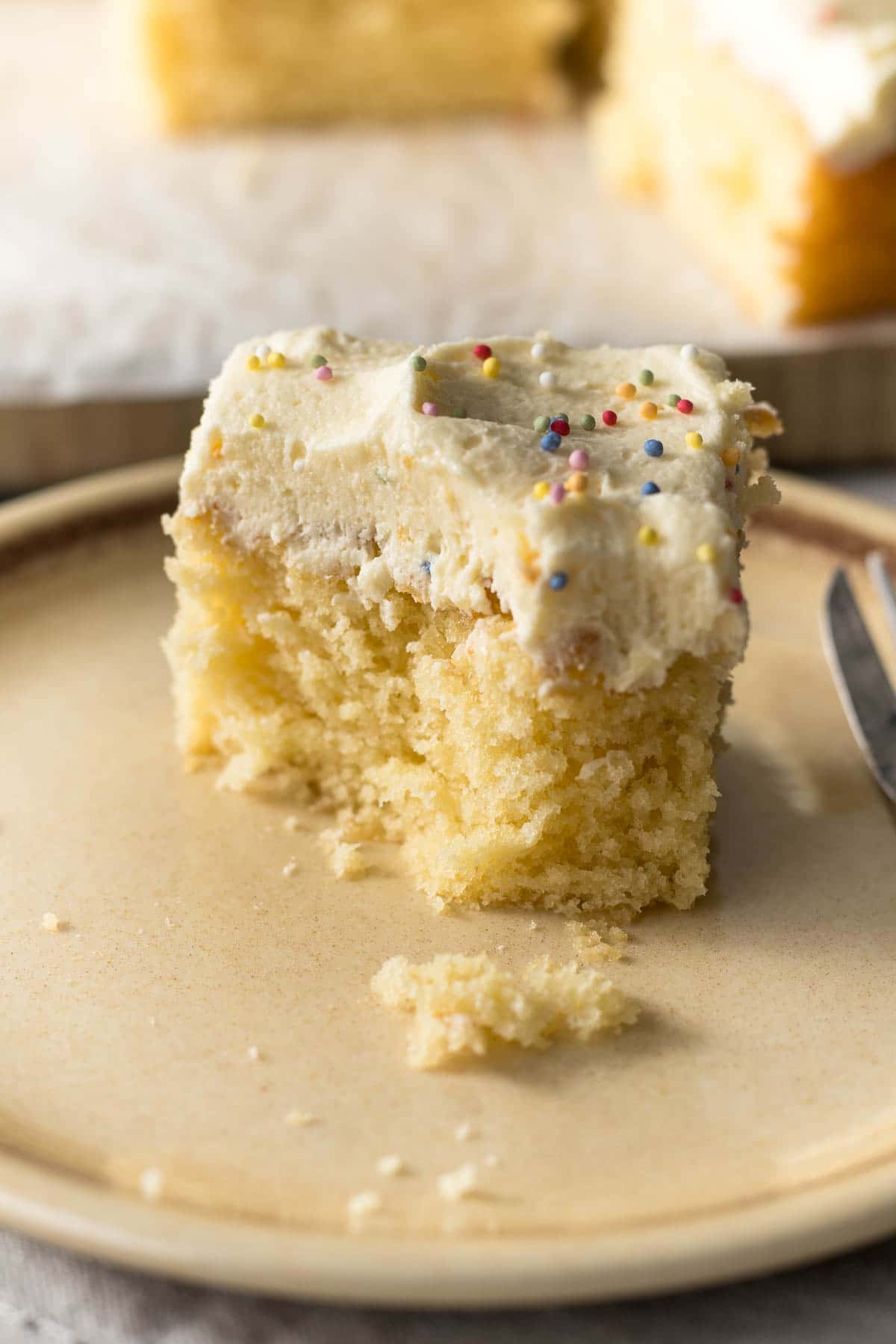
Rate & Review!
If you made this recipe, please leave a star rating! It gives my readers and me helpful feedback. If you want more recipes, subscribe to my newsletter, and follow me on Instagram, Pinterest, and Facebook!
Recipe Card
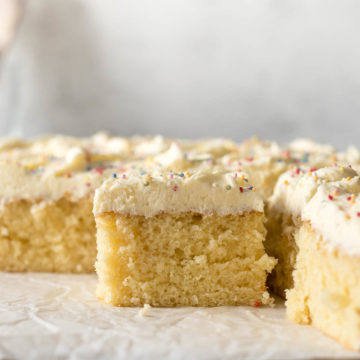
Vanilla Tray Bake Cake (Sheet Cake)
Equipment
- Rectangular Cake Pan (13x9 Inch/33cmx23cm)
- Stand Mixer OR
- Electric hand mixer
Ingredients
Vanilla Sponge
- 250 grams plain flour (all-purpose, standard grade - Note 1)
- 4 teaspoons baking powder (Note 2)
- ½ teaspoon table salt
- 125 grams butter (Note 3)
- 3 eggs (medium/large)
- 300 grams white granulated sugar
- 4 teaspoons vanilla extract
- 240 grams milk (note 4)
Buttercream Icing/Frosting
- 230 grams butter
- 500 grams icing sugar
- 1 tablespoon vanilla extract
- 1-4 tablespoons milk
- ½ teaspoons table salt
Instructions
- Preheat the oven the 180°/350°. Grease and line a 9"x13" (23cm x 33cm) rectangular cake tin.
- Whisk together the flour, baking powder and salt. Set aside. Melt the butter and allow it to cool while moving on to the next step.250 grams plain flour, 4 teaspoons baking powder, ½ teaspoon table salt, 125 grams butter
- In a large mixing bowl beat the eggs and sugar until light and fluffy and has doubled in volume. About 3-5 minutes using an electric hand mixer/stand mixer.3 eggs, 300 grams white granulated sugar
- Add in the vanilla and mix through. Then pour the butter slowly down the side of the bowl with the mixer running. Mix until well combined. Similarly, add in the milk and mix through.125 grams butter, 4 teaspoons vanilla extract, 240 grams milk
- Add in half the flour mixture and mix through on a low speed. Then add in the other half and mix until combined.
- Pour the batter into the prepared baking tin. Smooth to the edges. Bake for 25 to 30 minutes or until a cake tester comes out clean from the centre of the cake. Cool in the tin for 10 minutes before turning out onto a cooling rack to completely cool.
- To make the icing/frosting, beat the butter until the butter has lightened in colour. Add in the vanilla and salt, and beat together. (If using the stand mixer, use the whisk attachment).230 grams butter, 1 tablespoon vanilla extract, ½ teaspoons table salt
- Add in the icing sugar one third at a time, and mix thoroughly. Add in 4 to 8 tablespoons of milk (start with 4 and work your way up.) and mix until you have a soft spreading consistency. Then beat the frosting for 3 to 5 minutes until soft, fluffy and ready for spreading.500 grams icing sugar, 1-4 tablespoons milk
- Plop the frosting/icing over the top of the completely cooled cake, smooth until mostly even using an offset spatula or the back of a dessert spoon. Then create swirly patterns on the top if desired.
Notes
- The original recipe contained 300 grams or 2½ cups of flour. If you want to stick to this amount of flour the recipe works perfectly fine.
- If baking at altitude I would decrease the baking powder to 3 teaspoons.
- I use 125 grams of butter which is 9 tablespoons, a tablespoon more than 1 stick of butter.
- When I decreased the flour for the updated recipe, I decreased by milk from 250 grams to 240 grams (this is closer to a US cup of milk). Increase the milk to 250 grams if using the original recipe.
Frosting/Icing
If you prefer less icing or frosting on your cake, simply half the recipe using the "½" button. Or freeze additional frosting in an airtight container for up to 3 months.Storage and Freezing
This cake can be stored at room temperature for 3 to 4 days in an airtight container. If you live in a warm climate and prefer keeping your cake in the fridge please store it in an airtight container and allow it to come to room temperature before serving. This cake can be frozen in individual pieces wrapped in cling film or plastic wrap and then in an airtight container for up to 3 months. Remove the cling film before defrosting to ensure the icing or frosting doesn't stick to the cling film. If topping the cake with cream cheese frosting, the cake will need to be stored in the fridge in an airtight container.Nutrition
Nutrition information is an estimate. If scaling the recipe remember to scale your cook and bakeware accordingly. All temperatures stated are conventional, unless otherwise stated. Recipes tested in grams and at sea level.

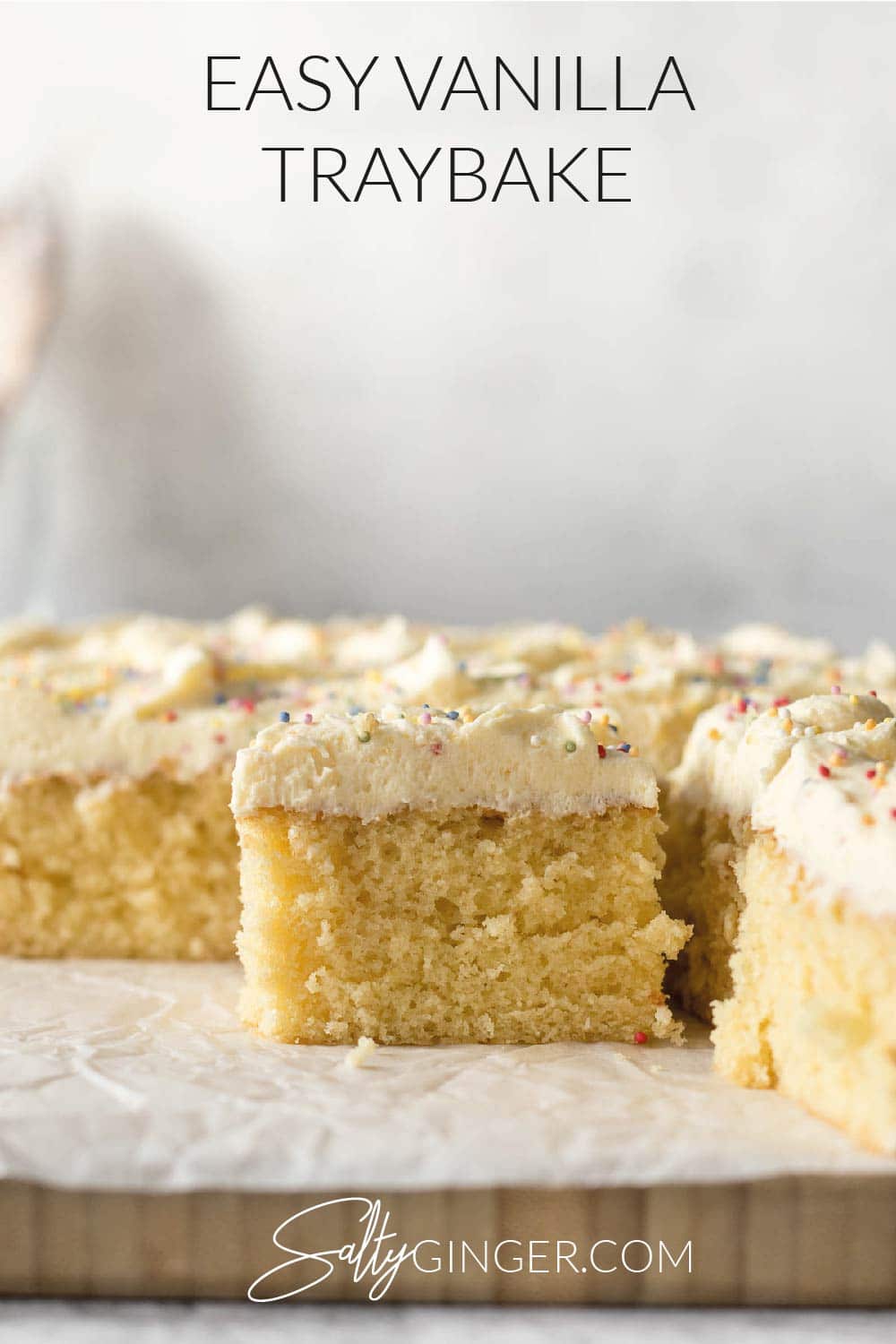
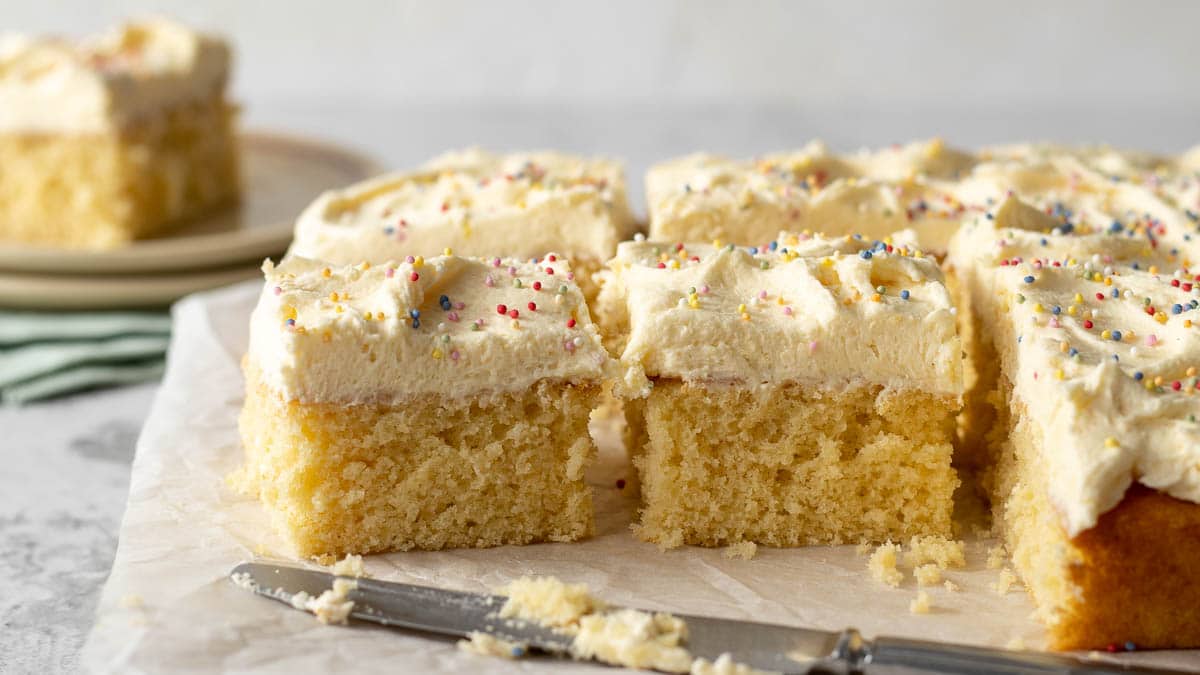

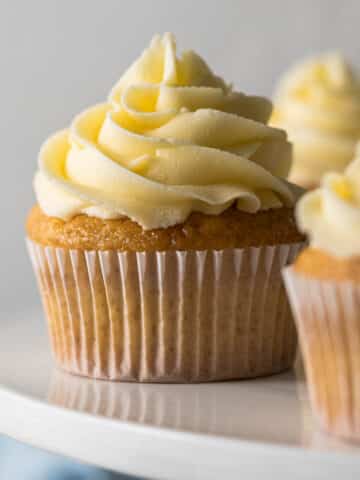
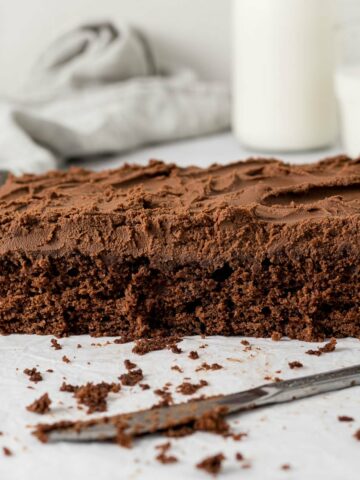
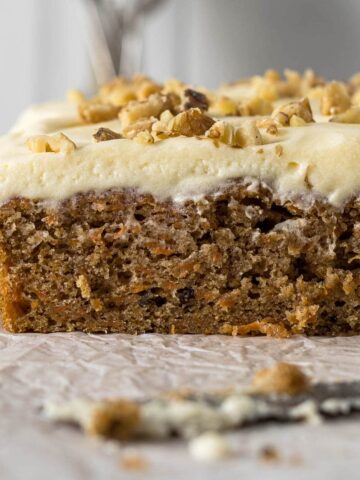
Hoogs says
Great Flavor and excellent density on this recipe....
Hannah says
Baked this with my 5 year old for a school bake sale. Easy recipe to follow, cake was lovely, light and fluffy.
We didn’t have plain flour so used SR with 2 tsp of baking powder as suggested.